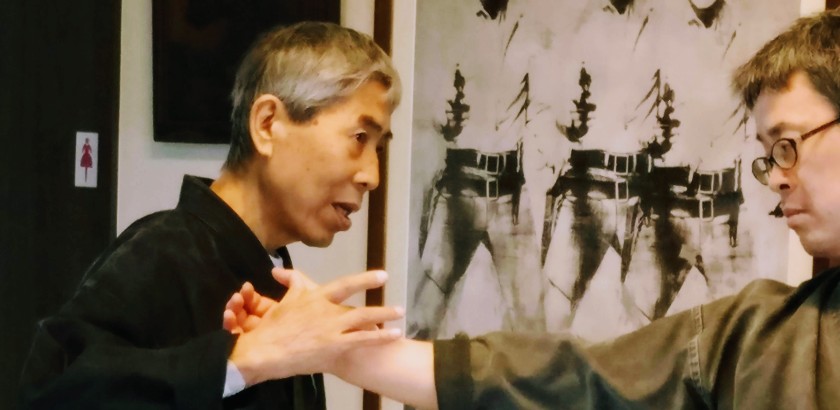
After trying my best for many years, I have come to the conclusion that I have to quit training. At least, this is the feeling that everyone must have had today during Senō sensei’s class.
Today only fourteen came to the Honbu to train. I found it strange. Friday night, more than seventy participants attended Sensei’s class. I guess the light morning rain is to blame.
Only black belts were training, and a majority of us were fifteenth dan. Everyone was lost. And I guess that many were wondering what they were doing there. No one in the room could reproduce the two techniques of Senō sensei today!
Many like me must have thought: “Ok, this is too much, I quit the Bujinkan!”
And the techniques were simple: Omote Gyaku (taijutsu); and Tsuke Iri (hanbō). Finding something more fundamental is hard. But in Senō sensei’s personal blender, they become impossible.
We could have done them as we usually do them, but then why bothering to attend a masterclass? The others might have thought that. Who needs to get out of the comfort zone? And it was raining, you know?
Even though I couldn’t do them the way he demonstrated them, I will give you here a few glimpses of what he did.
Omote Gyaku:
On a right Tsuki. You absorb the fist with the right hand in a “U” shape. Your legs are on the same line once you have the perfect distance.
You side-step to the left, and your body gives the attacking hand to your left hand. The right elbow stays close to the body. Power comes from the legs, not the arms.
It is essential to keep a certain distance between Uke and you. If you get too close, he will attack with the other fist.
Your body is now on the right side of Uke, your feet in Shizen.
You hook Uke’s thumb with yours while your forefinger creates a Shiten on the wrist/forearm (see picture). There is no force.
Then using the other fingers as if playing the piano you turn the soft grip from the right hand to the left. The “piano” movement happens at the same time you move your left leg forward.
His hand is now in Omote Gyaku at his side. You lower his arm and apply Omote Gyaku. This takes his balance. It is very subtle.
If you did that, the way I describe it, then you are better than me. Let me know in the comments.
Tsuke Iri with Hanbō:
On a Tsuki, you step backwards while being in contact with Uke’s arm. Your Hanbō is in line with the fist. The Waki Uchi is replaced by the Hanbō placed on top of the shoulder. Pulling the weapon and the arm to get his balance, you do a twist to the arm while stepping to the side. When you do that, it keeps the tip of the Hanbō in place on top of the shoulder. If you did the correct footwork, you are now more on the right side of Uke. From there, you exchange hands (arm/Hanbō) and continue to move towards Uke. Your Hanbō goes down vertical on the outside of Uke’s body. It locks Uke, and you take his balance with your footwork.
As I never figured out how to do the change of the hands, I never reached the right end of the movement. Once again, if you succeed, let me know in the comments.
Two hours, two basic movements. And a strong feeling of despair for everyone that attended the class today.
How come after so many years, we are unable to get this subtlety in our taijutsu. Is it time to accept the Bujinkan is not made for us? Or should we come more often, and learn with a “student mind,” the many things we still have to grasp? I guess the second option.
The difficulty of these basic moves is the reason why after many waza it says “there is a Kūden.”
As you all know, with his swollen legs Senō sensei cannot walk. Each step is painful. But, each Saturday, he comes and teaches at the Honbu, no matter what. No one forces him to do it. He does it because of his commitment to the Bujinkan and to Sensei. The Bujinkan is about resilience and perseverance.
And still, only fourteen attended his class!
_______________________________________
Online streaming www.koimartialart.com




Had almost the exact same experiences in Senos classes some of the time, but had a few successes too, within the two weeks just before you arrived.
LikeLike
This only serves to reinforce my desire to train with Seno sensei on my next trip.
Thank you for the post!
LikeLike
Shame on them for not training! They are not ill. Just lazy.
LikeLike
Every time I read something like this, it just makes me want to train more, rather than discouraging me. The thought that I still have so much to learn, so much to understand, is uplifting to me.
LikeLike